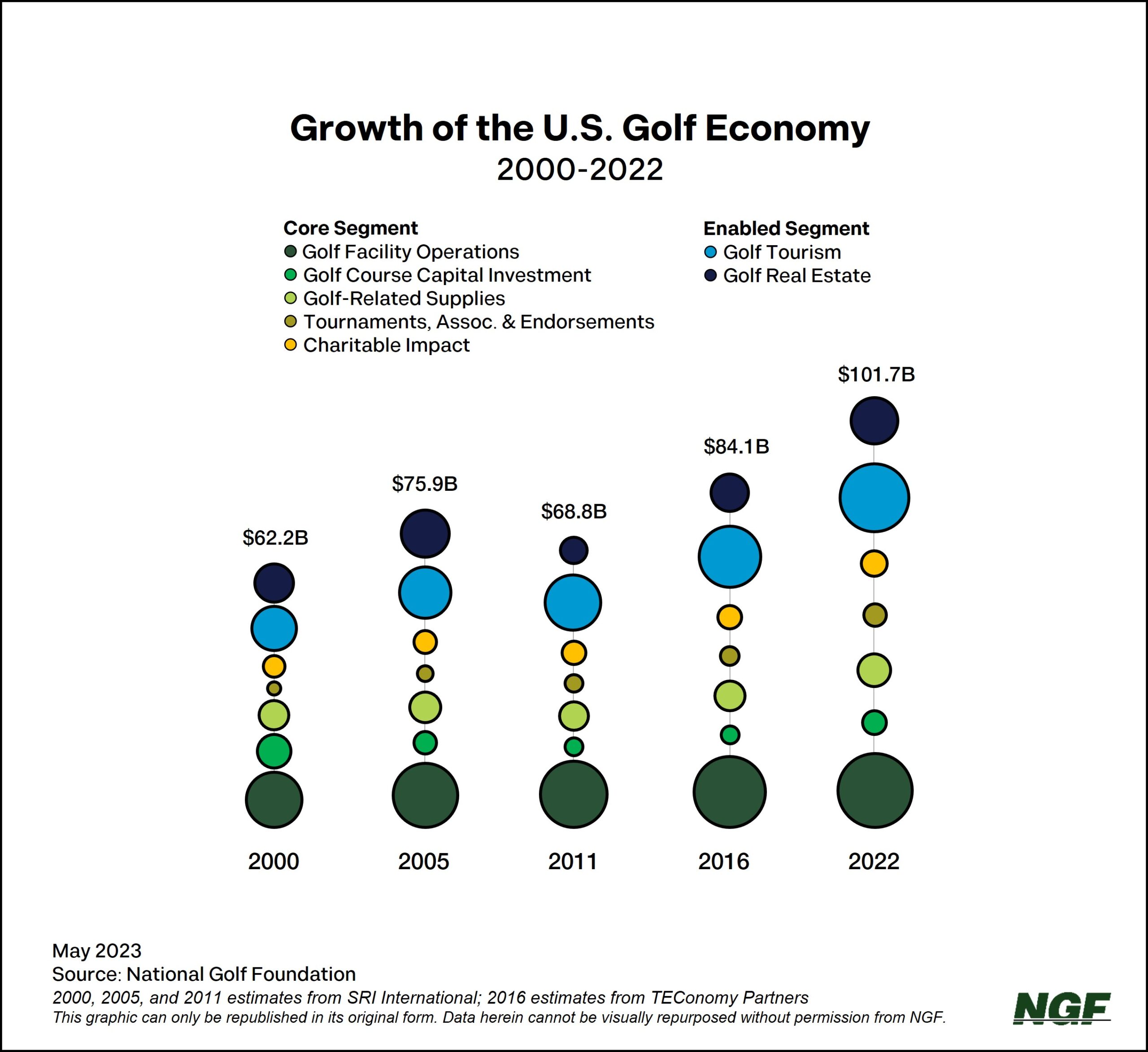Contextualizing the U.S. Golf Economy
(
You may have heard that golf is now a $102 billion industry in the U.S. – 20% larger than it was in 2016, the last time there was a proper quantitative review of the game’s economic contributions.
$102 billion certainly sounds like a lot, but numbers like this aren’t all that easy to grasp. So, here’s some (hopefully) helpful context. $102 billion is five times the revenue of the NFL. It’s roughly the global income of UPS, which delivered an average of 24.3 million packages per day in 2022. It’s 25% more money than Tesla, P&G and The Walt Disney Company made last year, 120% more than Nike brought in, and 220% more than Netflix.
You want economic proof that golf is not just a game, but a lifestyle? There it is.

Most can appreciate that golf is big business, but what’s easily lost is the tremendous economic ripple it triggers. Beyond the 12 figures in direct spending (from playing fees, hitting bay fees, member dues, equipment, apparel, trips, simulators, course renovations and more), golf supports another $125 billion in business-to-business activity and household spending (from golf-related labor income). This means almost a quarter of a trillion dollars ($227B) in total economic output – about enough to crack the list of top 50 countries by GDP.
Impressed yet?
Consider the industry’s philanthropic contributions. No sport has as significant a charitable effect as golf, which enabled $4.6 billion in giving in 2022. Need perspective? That’s approximately 1% of all charitable giving in the U.S. ($485B), from individuals, bequests, foundations and corporations combined.
There was much to share and celebrate earlier this month on Capitol Hill, as National Golf Day returned for its 15th edition. The team here at NGF is proud to have played a small role in building the story of golf’s evolution and impressive economic scope, having spent the past several months conducting a broad array of research to develop the industry’s latest National Economic Impact Report.
Studies like these are essential for communicating golf’s profound and wide-ranging effects. And not just nationally – NGF has also conducted economic research for Colorado, Indiana, Massachusetts and Oregon over the past two years. The latest report, developed for the Alliance of Massachusetts Golf Organizations (AMGO), was released this past week and reveals golf drove more than $2 billion in direct economic activity across the commonwealth, while affording about 52,000 acres of green space in one of the nation’s smallest states.
To learn more about golf’s full economic impact, check out the full report here.
Short Game.
"*" indicates required fields
How can we help?
NGF Membership Concierge

"Moe"
Learn From NGF Members
 Ship Sticks Secrets to a Hassle-Free Buddies Golf Trip
Ship Sticks Secrets to a Hassle-Free Buddies Golf Trip
Whether you’re the head planner of your upcoming buddies golf trip or simply along for the ride, we’ve gathered a few easy ways to keep everyone in your group happy.
Read More... Golf Course Turf, Soil and Water Quality Diagnostic Testing
Golf Course Turf, Soil and Water Quality Diagnostic Testing
As humans, we see our primary care physician on a regular basis to proactively evaluate our vital signs. Likewise, a superintendent should perform frequent diagnostic testing on their golf course.
Read More... Unlocking Distance: Launch Conditions and Angle of Attack
Unlocking Distance: Launch Conditions and Angle of Attack
We’ve long known that higher launch and lower spin is a powerful combination for generating consistently long and straight tee shots. A key factor in optimizing launch conditions, one often overlooked, is ...
Read More...





